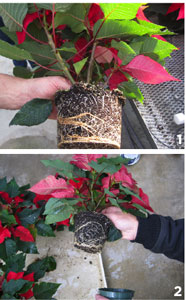7/26/2013
Wetter is Better
Dr. Royal Heins

On November 13, 2008, I walked into Henry Mast Greenhouses to meet with Leroy Devries, Shawn Koepnick and John Davies. It was an ugly November day in Michigan—overcast, raining, windy. And there, in the first bay of poinsettias we viewed, the crop was being flood irrigated.
Flood irrigated? On such a day? Everyone knows that poinsettias shouldn’t be irrigated on such a day or in such a way.
I’ve often shared that I learn something every time I visit a greenhouse. And this day, I learned something that’s changed my thinking of irrigation and poinsettia production and helped many growers manage Pythium in poinsettias ever since.
For a number of years, I’d observed the poinsettia root systems at Henry Mast Greenhouses were among the best I’ve ever observed at any facility (Figure 1). And the Mast Greenhouses growing team used the smallest amount of fungicide of all of the growers that I visited. So what was the secret?
Leroy shared that he didn’t want a poinsettia to ever become so dry that the soil surface of the pot became “paper-bag brown.” The reason is that, in his eyes and experience, a water stress was the first step towards Pythium root rot in poinsettias.
Yet tradition suggested that one should let a poinsettia have a “normal” wet-and-dry cycle. The same tradition also admonished a poinsettia never be watered to the point of being kept “wet.”
This is what I believed and what most people believed at the time. It was better to run a poinsettia on the drier side than on the wetter side to avoid Pythium. This treatment was borne out by actual experience that wet poinsettia plants often developed severe Pythium root rot.
Since learning from Leroy, Shawn and John to never let a poinsettia dry out, I’ve shared these observations with many growers. Without exception, everyone who’s adopted this new tradition has had little or no Pythium root rot. And anyone that’s allowed their crop to dry, even only once, has experienced Pythium.
One day I set out to see how “wet” a healthy poinsettia crop could be kept without Pythium root rot. I decided to put some poinsettia plants in a tray with about a half-inch of water so the plants sat in standing water continuously. After two weeks, roots were still white without Pythium losses (Figure 2). I’m not advocating that poinsettias be grown in standing water; it’s just that by itself being kept moist-to-wet doesn’t cause Pythium.
The term “wetter is better” has gained traction in producing poinsettias with some growers. (“Wetter is better” can be credited to Arie VanWingerden, as he’s the first person I heard use it.)
Success is predicated on good media. The plants must be grown in media that provides good aeration. Otherwise, one may have issues with a poorly aerated soil.
However, a warning: Should your crop ever get dry—to the point of “paper-bag brown”—then the “wetter is better” approach could become a disaster, as the probability of Pythium is very high. If you find your crop gets dry, you’ll probably need to revert back to the old way of growing where plants are grown drier instead of wetter. And you should consider a preventative fungicide application.
This means a poinsettia crop should never be dry starting at stick or transplant. In the old world of irrigating poinsettias, the idea was “if in doubt, don’t.” In this world of irrigation, “if in doubt, do”— which of course, is exactly opposite of what we believed for so many years.
Along this same line, if rooting in a liner and then transplanting, don’t allow roots to become dry in the liner or to grow out and become root pruned by dry air. This can be the start of a Pythium infection that you’ll fight until the crop is sold.
Good luck with your poinsettia crop this season.
GT
Dr. Royal Heins is Senior Technical Specialist with Fides-Oro and can be reached at r.heins@fides-oro.com or on the company website. Go to www.fides-oro.com and click on “Ask the Doctor.”